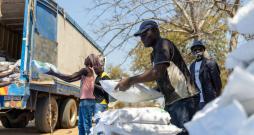No reasons that can justify their use

Once one sees, as I have, a community affected by hundreds, or thousands of unexploded cluster submunitions. Their livelihoods destroyed. Then there are no reasons that can justify their use in the first place.
– Branislav Kapetanovic at the Dublin Conference on Cluster Munitions, 2008.
As we approach the International Day of Peace on September 21st, we as Canadians have the opportunity to reflect on how we can play a role in creating a more just and peaceful society.
On this day that has traditionally been marked by a 24-hour ceasefire, the conflict between Russia and Ukraine continues. Western countries, including Canada, play an active role in the conflict by providing military support to Ukraine’s armed forces. This support includes the recent decision by the United States to provide the Ukrainian military with cluster munitions.
Cluster munitions are weapons that release many small bombs, covering an area up to the size of several football fields. More than 111 countries have signed on to the convention on cluster munitions, which explicitly forbids their use. This includes Canada, but not Ukraine, Russia, or the United States.
The convention on cluster munitions has three main provisions.
"Each State Party undertakes never under any circumstances to:
- Use cluster munitions;
- Develop, produce, otherwise acquire, stockpile, retain or transfer to anyone, directly or indirectly, cluster munitions;
Assist, encourage or induce anyone to engage in any activity prohibited to a State Party under this Convention."
The convention was introduced to eliminate the use of these weapons, which pose an unacceptable risk to civilians due to their indiscriminate nature and large area of impact. Cluster munitions have high rates of failure; unexploded bombs kill and injure civilians years, or decades after their initial use.
For example, in Laos – where the U.S. dropped over 270 million cluster bombs during the Vietnam War – MCC spent several decades partnering with organizations to destroy thousands of unexploded ordinances. These unexploded bombs have been killing and maiming people in these communities for years, and about 25% of casualties are children. In 2023, 50 years after the peace accords that ended the Vietnam War, there are still an estimated 80 million unexploded bombs in Laos. This firsthand experience of the devastation caused by these inhumane weapons led MCC staff, including Titus Peachey and Linda Gehman Peachey, to take a leading role in advocating for the eventual signing of the ban on cluster munitions by 111 countries.

The cluster munitions sent by the U.S. to Ukraine are expected to be “M864 and M483A1 shells for 155mm howitzers.” Since the start of the war, Canada has provided four of these same 155mm howitzers to Ukraine and provided training to Ukrainian soldiers on how to use them. The weapons and training provided to Ukraine from Canada could now be used in the deployment of cluster munitions. As a state party to the ban on cluster munitions, this should be deeply concerning to Canadians and their leaders.
Following the news that cluster bombs would be sent to Ukraine, Canadian Minister for Foreign Affairs, Mélanie Joly, stated that, “we do not agree with the American position. And we've mentioned it to the American officials. Meanwhile, what I think the alliance needs to focus on is really expanding the defence industrial capacity, because we're in this position right now.”
This statement from the Minister demonstrates a single-minded focus on violent and armed resolution to war. The Minister immediately deflects from the devastating implications of cluster bombs, right back to increased military support. Why is more violence still the only solution being discussed, especially with the possibility that Canadian resources may be used to perpetrate a human rights catastrophe?
The truth is, there are other options. For example, in 2016 a negotiated peace ended decades of conflict between the Colombian government and the largest armed group, the FARC. This fighting ended with a slow de-escalation of violence and over 7000 guns being symbolically handed over. This is an example of the non-violent solutions that our politicians could be talking about.
Canadian civil society leaders, like Cesar Jaramillo of Project Ploughshares, are already calling on the Canadian government to take a leading role and work for peace in Ukraine. When we see the devastating consequences of war, like those caused by cluster bombs, let us remember that there is always another choice and encourage our leaders to pursue peace.
Wondering what you can do? You can send a letter to the Canadian Government encouraging them to pursue non-violent responses to conflict and to give peace a chance!
Mackenzie Graham is the Advocacy and Program Associate for MCC’s Peace & Justice Office (Ottawa)

